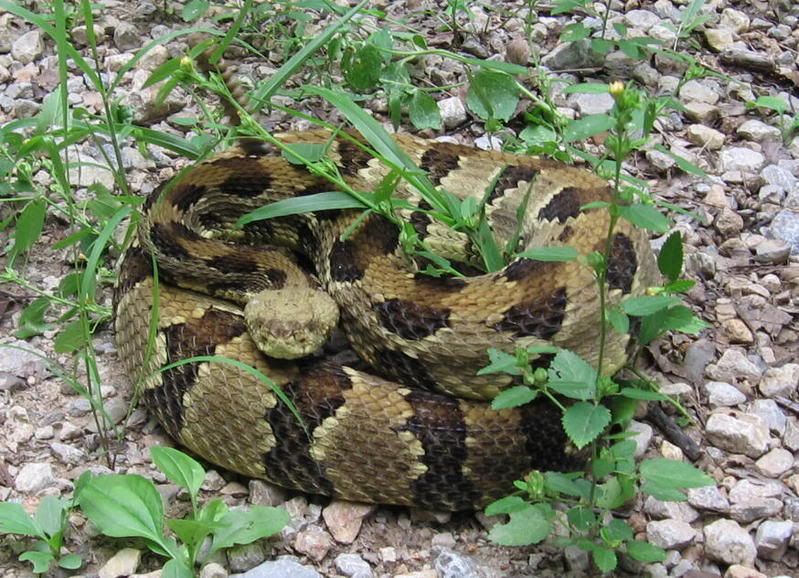
The scientific name of the timber rattler (Crotalus horridus) is not as bad a moniker as I had originally thought. Crotalus refers to the rattle of the rattlesnake, and horridus, which seems to imply a terrifying animal, just refers to its raised stalking pose. Its bite is venomous, but apparently not as deadly to people as other rattlesnakes. According to a Minnesota herpetology site, the last lethal timber rattler bite in Minnesota was in the 1800’s.
Timber rattlesnakes are a middling size snake, somewhere between 3 and 4 feet long, and they have amazing camouflage for lying in wait among the leaf litter in the forests they call home. They ambush small mammals by positioning themselves conveniently in the paths the rodents run along. The females give birth (yes, birth. Not egg-laying) only every three years, and it takes her about five years to get to maturity. Even with their 20-year lifespan, that only leads to about six litters.
I’m sure no one will be surprised when I say that development, cars, and wanton killing are the leading threats to the timber rattlesnake. In fact, the wanton killing leads to an interesting example of selection at work. For the last 200 years, if a snake struck at a person, it got killed. If a snake even rattled at a person, it got killed. This leads, fairly quickly, to quiet, generally non-aggressive snakes. Which can be a problem, since they only rattle to let you know to not step on them. A friend and co-worker of my dad’s apparently walked along a line in a forest in southern Ohio multiple times, only to look down once and see a timber rattler, silently sitting right on the line.
On the site where the Ohio Department of Natural Resources asks people to help report sightings of timber rattlers, it is actively denied that the snakes are being released in Ohio. Why would a department of natural resources have to actively deny a conservation effort? The reason lies around a myth; a myth surrounding timber rattlesnake conservation that is far more exciting than any real conservation efforts would ever strive to be. According to this myth, ODNR uses black helicopters at night to drop rattlesnakes into potential habitats. That’s right, black helicopters. At night. This myth neglects to take several factors into account: A) Do you really think ODNR has the funding to buy several black helicopters? and B) If they really wanted to surreptitiously release rattlesnakes, wouldn’t three guys, a pillowcase full of snakes, and an ATV make more sense, both economically and logistically?
Oh well, myths will be myths.
1Tried to get a good timber rattler picture. Didn’t turn out as well as I had hoped.
2This is a warning to any die-hard readers (yes, both of you): I’m going to be on a small boat in the Pacific for three weeks. My parents and girlfriend might not get a phone call. Don’t expect a post.





No comments:
Post a Comment